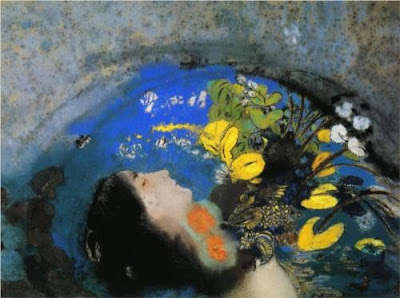 |
| Salvador Dali, Ophelia's Death |
However, we Blackbirds took a break. And went to a new coffee shop in town for a macchiato (me), black cherry soda (her), and a shared lemon sugar cookie (yum). What can I say -- it's our way.
While sharing that cookie, though, we started talking about something completely different. About another character, even more well known than and not even remotely connected to Ophelia, and how that character has become known for certain traits and ideas that originate from sources other than what we believe to be the original text. This character is revealed more in the way he is perceived by others, than by his actual appearance in the text. His personality is gathered from multiple cultures and stories. And the traits that make him most famous are mostly left up to interpretation.
It was kind of a shocking realization.
 |
| John Everett Millais |
 |
| Paul Albert Steck, Ophelia Drowning |
Culturally, however, she has become a female icon (for good or for bad, take your pick); she has become "OPHELIA," not just Ophelia. She represents love lost and melancholy. Depression. A lover to scorn, a betrayed daughter, a sister to avenge. A madwoman. Ultimately, a woman who can't make her own choices about her life; she is bound to be obedient to her father or her husband, given the restrictions of the society of her time. She is the representation of goodness, in contrast with Hamlet's faithless mother, Gertrude. But, eh, Hamlet still verbally abuses Ophelia, and she dies (or kills herself -- it's debatable).
 |
| Dante Gabriel Rossetti |
Old Shakespeare lets Hamlet's mom break the news:
When down her weedy trophies and herself
Fell in the weeping brook. Her clothes spread wide;
And, mermaid-like, awhile they bore her up:
Which time she chanted snatches of old tunes;
As one incapable of her own distress,
Or like a creature native and indued
Unto that element: but long it could not be
Till that her garments, heavy with their drink,
Pull'd the poor wretch from her melodious lay
To muddy death.
The description of her death, from Gertrude's lips, sounds not too bad actually. She looked good -- mermaid-like -- and she didn't really even realize, "Hey, I'm drowning!'' She was too busy singing. Darn those heavy, wet clothes!
 |
| John William Waterhouse |
So, over the years, artists have gleaned some important (to them, at least) ideas from her story -- Ophelia was pretty, she had some flowers, and she had some nice clothes. Oh, and she was kind of sad. And they ran with it, making her into the poster child for "Woe is me!" and "He don't love me no more!" Oh, and "Goodbye cruel world!"
 |
| Paul Delaroche |
 |
| Arthur Hughes |
 |
| Henry Lejeune |
Personally, I prefer Natalie Merchant's version of her character, highlighted in her album, aptly titled Ophelia. The entire album is a statement for women's rights, arguing against limiting images of women as "mother" or "whore", and calling out Ophelia as a woman who had to fight against patriarchal, male dominated society. It also helps that the songs are really good -- beautiful and simple and strong.
Ophelia's mind went wandering
You'd wonder where she'd gone
Through secret doors
Down corridors
She'd wander them alone
All alone...
 |
| Odilon Redon |
But what would today's Ophelia look like? Fashion has the answer. She can be soft and dreamy, like this:
 |
| Rooney Mara for Vogue |
 |
| Coco Rocha |
 |
| Michael James Talbot |

No comments:
Post a Comment
Note: Only a member of this blog may post a comment.